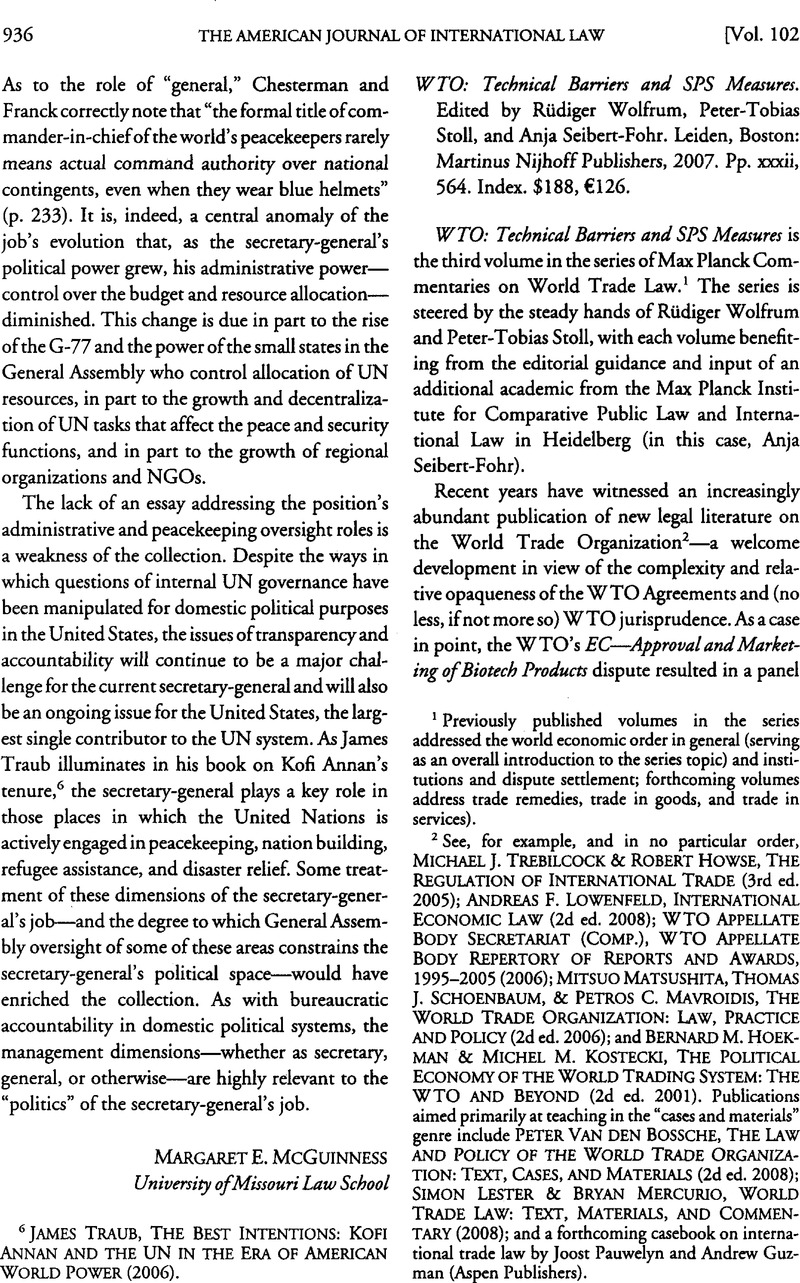No CrossRef data available.
Published online by Cambridge University Press: 27 February 2017

1 Previously published volumes in the series addressed the world economic order in general (serving as an overall introduction to the series topic) and institutions and dispute settlement; forthcoming volumes address trade remedies, trade in goods, and trade in services).
2 See, for example, and in no particular order, Michael, J. Trebilcock & Robert, Howse The Regulation Of International Trade (3rd ed. 2005)Google Scholar; Andreas, F. Lowenfeld International Economic law (2d ed. 2008)Google Scholar; WTO Appellate Body Secretariat (Comp.), WTO Appellate Body Repertory of Reports and Awards, 1995–2005 (2006)Google Scholar; Mitsuo, Matsushita Thomas, J. Schoenbaum & Petros, C. Mavroidis The World Trade Organization: Law, Practice and Policy (2d ed. 2006)Google Scholar; and Bernard, M. Hoekman & Michel, M. Kostecki The Political Economy of The World Trading System: The WTO and Beyond (2d ed. 2001)Google Scholar. Publications aimed primarily at teaching in the “cases and materials” genre include Peter Van Den, Bossche The Law And Policy Of The World Trade Organization: Text, Cases, And Materials (2d ed. 2008)CrossRefGoogle Scholar; Simon, Lester & Bryan, Mercurio World Trade Law: Text, Materials, And Commentary (2008)Google Scholar; and a forthcoming casebook on international trade law by Joost Pauwelyn and Andrew Guzman (Aspen Publishers).
3 See Understanding on Rules and Procedures Governing the Settlement of Disputes [hereinafter DSU], Art. 3.2, Apr. 15, 1994, Marrakesh Agreement Establishing the World Trade Organization, Annex 2, in World Trade Organization, The Results of the Uruguay Round of Multilateral Trade Negotiations: The Legal Texts 354 (1999)Google Scholar, 1869 UNTS 401. An important WTO panel report, United States—Sections 301–310 of the Trade Act of 1974, para. 7.76, WT/DS152/R (adopted Jan. 27, 2000), found that the WTO is designed to provide security and predictability for the multilateral trading system, which is “composed not only of States but also, indeed mostly, of individual economic operators.”
4 The editors explain in their preface that they have chosen to expand the book’s coverage because “technical barriers to trade also comprise measures that take effect only within domestic markets of members” (p. ix). Slightly neglected in this respect, however, is the most-favored-nation principle (GATT Article I); SPS measures and TBT, even when enforced at the border and not as internal measures, may result in de facto discrimination among different foreign sources of goods, in violation of the MFN principle. Nonetheless, the book includes no chapter on this principle.
5 The Kommentar form of section-by-section annotation has been a stalwart of German legal scholarship and practice since the Glossen of the late middle ages. See Anke, Freckmann & Thomas, Wegerich The German Legal System 11 (1999).Google Scholar
6 For the original aims of the American Law Institute in its Restatement project, see <http://www.ali.org/ali/thisali.htm> (n.d.).
7 The SPS section of the currently reviewed volume begs comparison to the equally excellent, yet more thematic, treatise-like introductory commentary provided by Joanne Scott, as a single author, in The WTO Agreement on Sanitary and Phytosanitary Measures: A Commentary (2007).
8 Kurzkommentare are single-volume commentaries “strongly geared to practice needs”; Groβkommentare are significantly more detailed, multiple-volume commentaries. See Martina, Kammer & Rita, Exter Legal Research in Germany at the Crossroads of Traditional and Electronic Media: An Overview , sec. 5.1 (2001), at <http://www.llrx.com/features/germanlaw.htm>>Google Scholar.
9 Unfortunately, the book lacks an index of cases, which would have made it easier to trace the significance of particular disputes in the development of the law. One hopes that this omission will be rectified in future volumes and editions.
10 Witness, for example, the phrase “life and health of men” (p. 185) in lieu of “human life and health” or some such phrase.